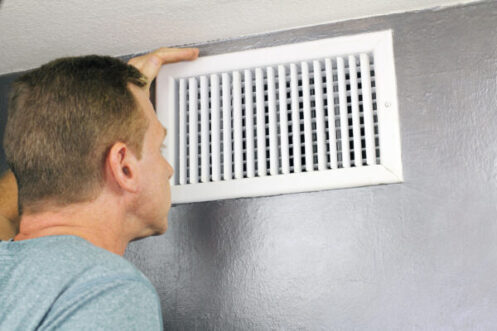March 12, 2023

All About IAQ Tests
Maintaining good indoor air quality is crucial for ensuring a healthy living environment for you and your loved ones. Indoor air quality is affected by a variety of factors, including outdoor pollution, household chemicals, and compromised ventilation systems. Poor indoor air quality can lead to health problems such as headaches, fatigue, respiratory issues, and even long-term health effects like heart disease and autoimmune disorders. Regular testing of indoor air quality is essential to identify potential sources of pollution and take appropriate measures to mitigate them. Testing indoor air quality at different times during the year can also help you identify seasonal changes that may affect indoor air quality, allowing you to take preventative measures to keep your home safe and healthy.
Factors That Impact Your Indoor Air Quality
What factors affect your indoor air quality? At any given time during the day, you may be surrounded by mold and mildew spores, volatile organic compounds, dust, and pet dander that can exacerbate respiratory issues and cause other health issues as well. Some of the more common factors affecting your indoor air quality include:
Outdoor Pollution
Outdoor pollutants such as smoke, dust, and pollen can enter your home and affect indoor air quality. As you spend more time indoors at certain times of the year, it becomes difficult to escape these pollutants that are trapped in your house’s HVAC system and living spaces.
Household Chemicals
Cleaning products, pesticides, and personal care products can release harmful chemicals into the air. The more you use these aerosol substances and cleaning solutions, the greater your levels of saturation will be. Consider switching to plant-based, all-natural formulas to clean up indoor air samples and remove toxins from your residence.
Building Materials
Certain building materials, such as paint and carpet, can release volatile organic compounds (VOCs) into the air. This off-gassing effect can hang in the air longer than you’d like, clogging up your HVAC system and causing potential hazards for your health.
Inadequate Ventilation
Inadequate ventilation can lead to a buildup of pollutants in the air. Homes that are sealed up tightly during winter and summer months continuously circulate stale air through their HVAC systems. Consider opening doors and windows periodically and using ceiling fans to move air through your house.
Pet Dander, Dust, and Debris
Pet dander, dust, debris, and dust mites can accumulate in carpets and upholstery, leading to poor indoor air quality. Vacuuming and cleaning often will help reduce the level of particulates moving through the air and keep your home’s indoor air quality cleaner.
Cooking and Combustion Residue
Cooking and combustion appliances such as stoves and heaters can release pollutants into the air. Use exhaust fans and crack open a window to release some of these harmful byproducts out of your living spaces.
Consequences of Poor Indoor Air Quality
Poor indoor air quality has both short-term and long-term consequences on your health. Some of the short-term consequences of exposure include:
- Nose, eye, and throat irritation
- Headaches and dizziness
- Fatigue and difficulty concentrating
- Allergic reactions
- Coughing and sneezing
- Exacerbation of respiratory conditions like asthma and bronchitis
Long-term exposure to poor indoor air quality can result in chronic conditions that have potentially life-threatening consequences. Some of these long-term issues include:
- Chronic respiratory diseases like COPD
- Heart disease and stroke
- Lung cancer
- Developmental and reproductive issues
- Neurological issues
- Increased risk of infection
- Development of autoimmune diseases
The severity of health consequences can vary depending on the individual’s sensitivity to pollutants and the duration of exposure. Regular testing of indoor air quality and taking appropriate measures to maintain good indoor air quality can help reduce the risk of these health consequences.
What’s An IAQ Test?
An indoor air quality test is a process of measuring the level of various pollutants and contaminants in the air inside a home, a building, or an enclosed space. The test is typically performed by a trained professional who uses specialized equipment to measure the concentration of various pollutants in the air, such as carbon monoxide, volatile organic compounds (VOCs), particulate matter, and radon.
The process of testing indoor air varies depending on your specific needs and concerns regarding quality. For example, if there’s a concern about mold, your test may include air and surface sampling for mold spores. If there’s a concern about radon, the test may include long-term monitoring to measure the average radon levels over a period of time.
Once the testing is complete, the results are analyzed, and your air quality assessment professional can provide recommendations on how to improve indoor air quality, such as improving ventilation, reducing the use of certain chemicals, and installing air filtration systems.
Regular indoor air quality testing is important to ensure a healthy living environment, especially for those with respiratory issues, allergies, or other health concerns. Investing in an IAQ assessment is an important step toward protecting your long-term health.
IAQ Process
An indoor air quality assessment typically involves the following steps for a residential home. A consultation with a professional indoor air quality testing service will be scheduled, during which they’ll ask you about your concerns and any specific issues that you’ve noticed. Your air quality inspector will then perform a visual inspection of the building or enclosed space to identify any potential sources of pollution, such as mold growth, water damage, or poorly maintained HVAC systems. Samples will then be taken from various areas of the building or enclosed spaces. Your inspector may also take surface samples, such as swabs of visible mold growth or dust from surfaces, to test for specific pollutants. Samples are then analyzed in a laboratory, where the concentration of various pollutants and contaminants is measured.
Once the analysis is complete, the inspector will provide a report that includes the results of the testing as well as recommendations on how to improve indoor air quality. The report may also include information on the potential health effects of the pollutants found. Recommendations will be made if necessary to address identified issues and take steps to improve indoor air quality.
What Does An Indoor Air Quality Test Cost?
The cost of an indoor air quality test for a home varies depending on several factors, including the size of your house, the number of samples needed, and the type of testing equipment used. A basic indoor air quality test can cost anywhere from $200 to $600.
For more comprehensive testing that includes multiple samples for a variety of pollutants, such as mold, radon, and volatile organic compounds (VOCs), the cost can range from $500 to $1,500 or more. Some testing services may also offer additional services, such as on-site consultation and follow-up testing, which can increase the overall estimate of costs for your test.
While the cost of an indoor air quality test may seem high, it’s a worthwhile investment in your health and well-being. Poor indoor air quality can have both short-term and long-term health consequences, and regular testing can help identify potential issues and take appropriate measures to improve indoor air quality.
Professional Service, Quality IAQ Solutions in St. Louis
Scott-Lee Heating Company has been proudly serving residents of St. Louis and the surrounding area since 1978. We offer services related to furnace repair, maintenance, and replacement, AC service and installation, commercial HVAC services, metal work, and indoor air quality inspections. We also provide top-notch service and solutions to make your home safe and comfortable all year Contact us today to schedule your indoor air quality assessment. We’ll find solutions to improve indoor air quality and protect your health!
